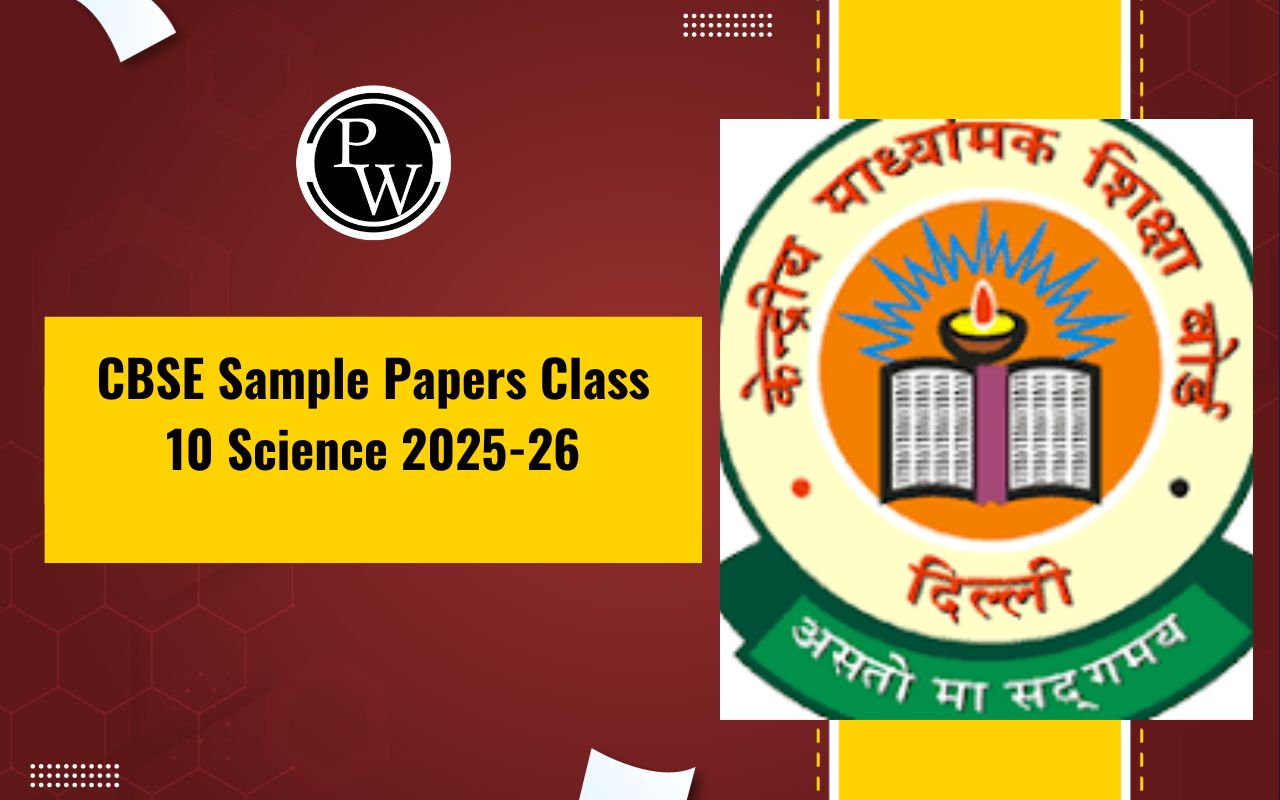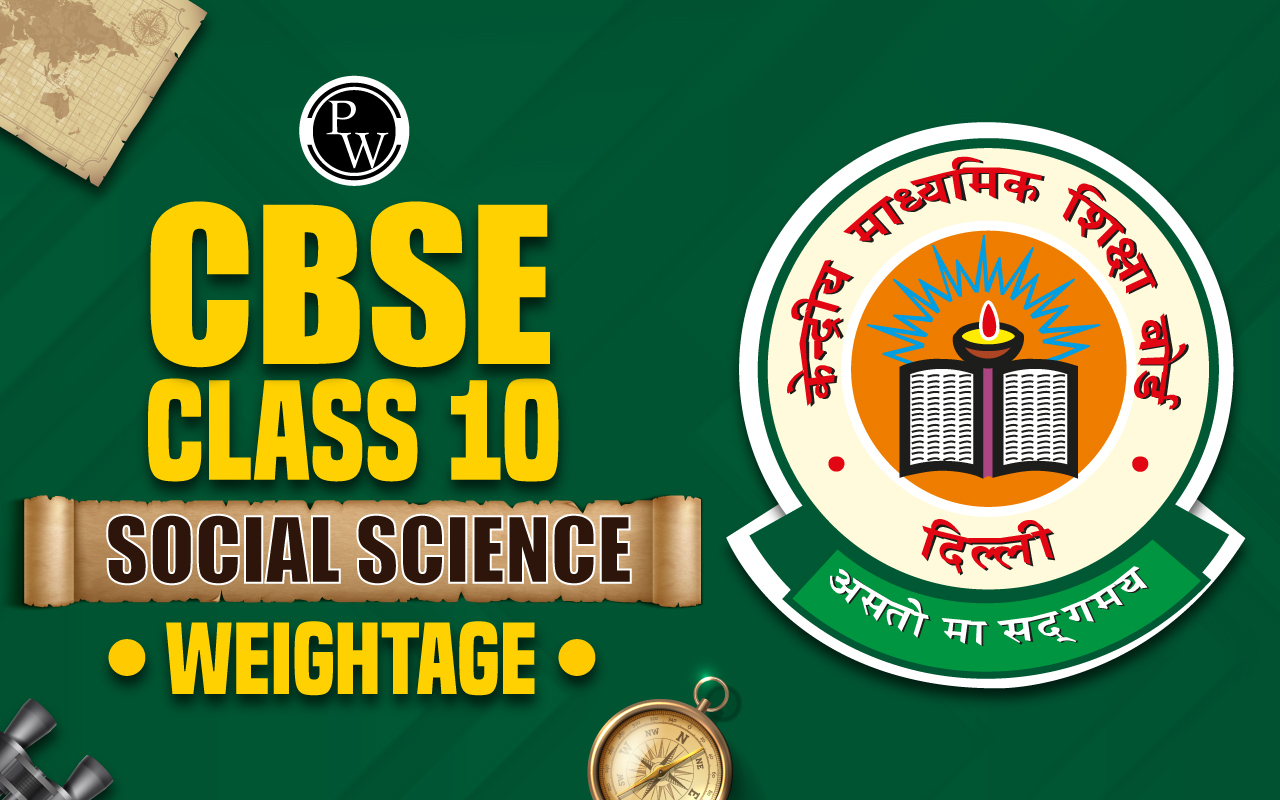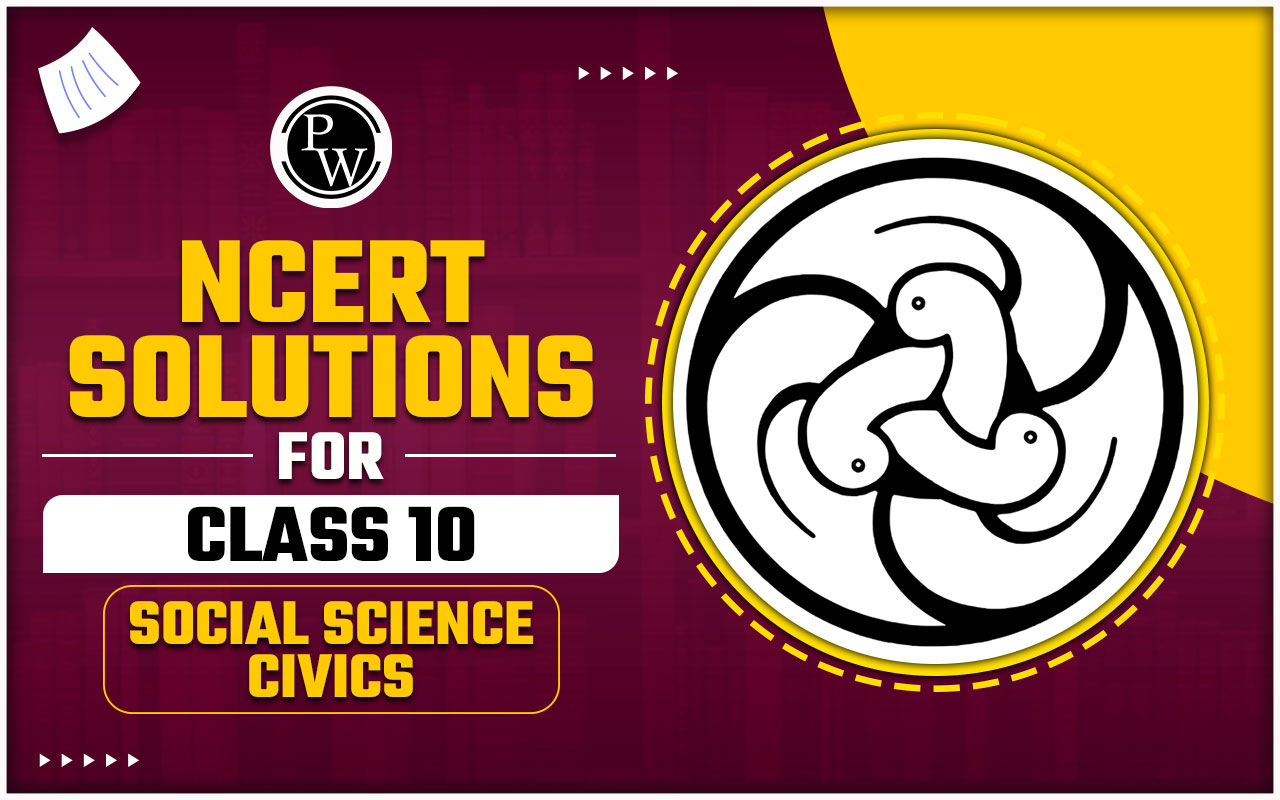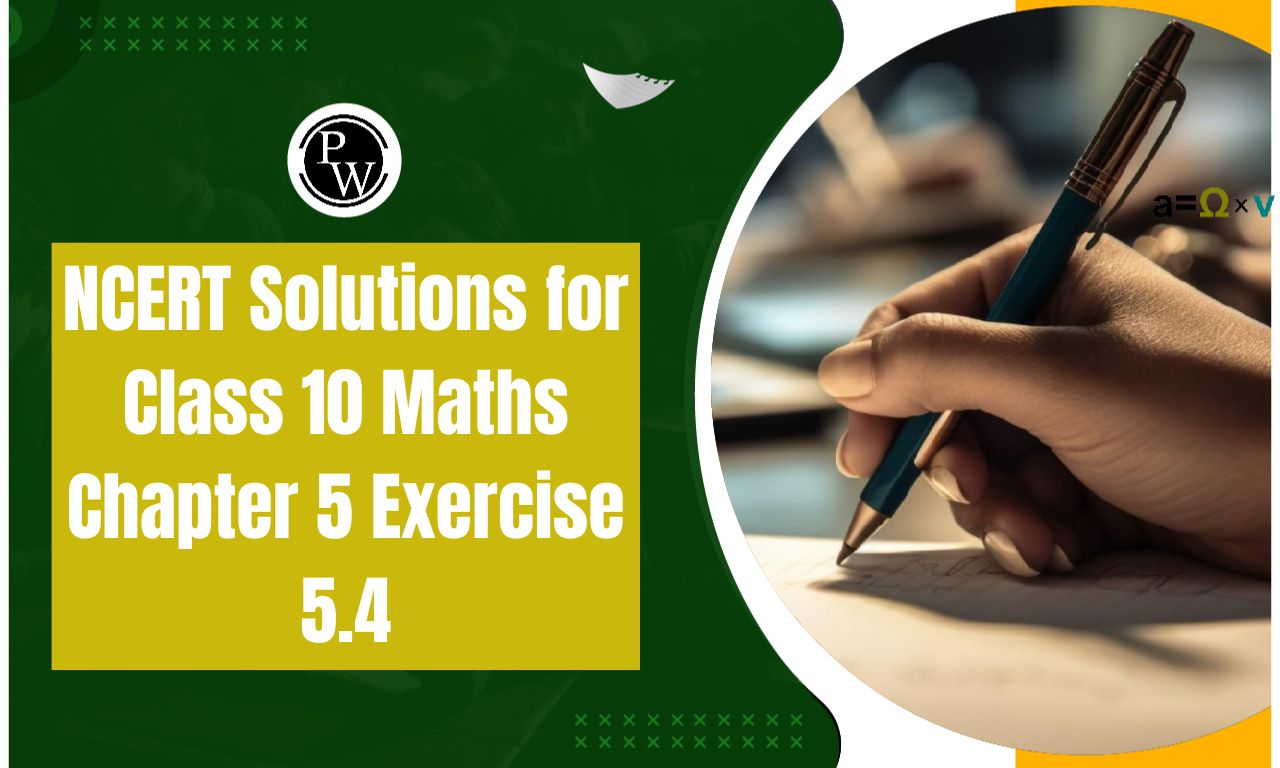

CBSE Class 10 Science Notes Chapter 7: Control and coordination are essential functions of the nervous system. The human body is quite intricate, especially when it comes to the nervous system, which adds a new layer of complexity.
Our brain and nervous system are more intricate than even the most advanced quantum computer. In this CBSE class 10th science ch 7, we will delve into the mechanism of control and coordination in the human body. We will explore how it operates, including the features of different neurons.Class 10 science chapter control and coordination notes will discuss the nervous and endocrine systems found in animals, as well as the hormonal system responsible for coordinating various body parts.
You can download and consult the class 10 biology chapter 2 notes to gain a good understanding of the chapter. These control and coordination class 10 notes provide comprehensive insights into the topic.
Control and Coordination Class 10 Notes
In class 10th science ch 7, the topic of control and coordination explains how different parts of the body work together to perform various functions.
The nervous system and hormonal system are the main control systems in humans. The nervous system uses neurons to transmit messages quickly, while the endocrine system releases hormones for slower but long-lasting effects.
Plants also show control and coordination through responses to stimuli, called tropic movements. These class 10 science chapter 7 notes help students understand concepts like reflex action, sensory and motor neurons, and plant hormones clearly, making exam preparation easier.
Animals- Nervous System:
- The nervous system is a system of organs that manages and organises actions in animals. It consists of the brain, spinal cord, and a network of nerves throughout the body. The nervous system handles sending, receiving, and processing messages in the form of chemical signals called impulses.
- Nervous tissue is a well-organised network of nerve cells or neurons designed to transmit information through electrical impulses. The basic unit of the nervous system is the neuron, which has three parts: the cell body (cyton), branched projections (dendrites), and a long process leading from the cell body (axon).
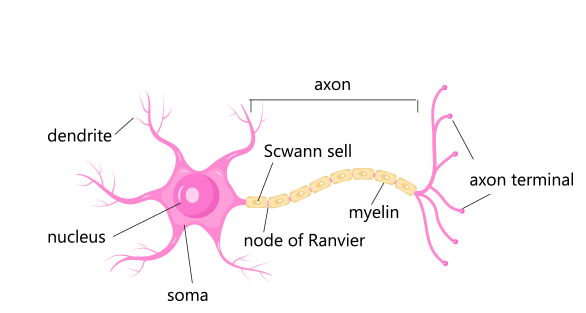
- A synapse is a link between two neurons. Nerves, which are strands of tissue extending from the brain and spinal cord, play a crucial role in conveying messages throughout the body and branching out to all regions.
- Neurons come in various shapes and sizes. The brain or spinal cord receives messages from sense organs through sensory nerves. Motor neurons relay messages from the brain or spinal cord to all the body's muscles and glands.
- An interneuron or relay neuron is a specific type of neuron connecting neurons in different parts of the central nervous system.
CBSE Important Questions for Class 10 Science
What Happens in Reflex Actions?
- A reflex action, commonly known as a reflex, is an automatic and almost immediate movement that happens in response to stimuli. The body produces a reflex activity in reaction to the surroundings.
- The process of sensing a signal or input and quickly responding with an output action is possible. This connection is termed a reflex arc. Despite the input information reaching the brain, reflex arcs are formed in the spinal cord. In higher animals, most sensory neurons don't go straight to the brain; instead, they connect in the spinal cord. For a speedy response, a reflex arc remains more effective.
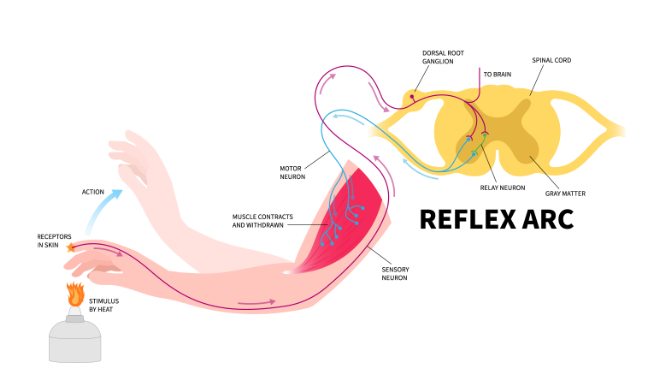
Human Brain
Types of the Nervous System
The central nervous system and the peripheral nervous system are the two parts of the nervous system.
Central Nervous System:
- The central nervous system includes the brain and spinal cord. It gets information from the body and sends instructions to certain organs. The brain has three main parts: the forebrain, midbrain, and hindbrain.
- The thinking part of the brain is the forebrain, which consists of the cerebrum and diencephalon. The cerebrum holds memory, intelligence, and senses like hearing, smell, and sight. The diencephalon deals with pressure and discomfort.
- The midbrain links the forebrain to the hindbrain and manages vision and hearing reflexes. The hindbrain is made up of the cerebellum, pons, and medulla. The cerebellum coordinates muscle actions and keeps balance and posture.
- The medulla oversees involuntary functions like blood pressure, salivation, vomiting, and heart rate. The spinal cord is shielded by the vertebral column and runs from the brain's medulla through the backbone.
Peripheral Nervous System:
The cranial and spinal nerves emerge from the brain and spinal cord, respectively, to form the peripheral nervous system.  What Safeguards are in Place for the Tissues? The skull provides strong protection for the brain, and there's a fluid called cerebrospinal fluid that absorbs extra shock. What is the Mechanism by Which the Nervous System Causes Action? When a nerve message gets to muscle fibres, they need to move. The shape of muscle cells changes, causing them to get shorter. Special proteins in the muscles alter their shape and arrangement in response to electrical signals from nerves. This results in the muscle cells taking on a new shape due to the changes in protein groupings.
What Safeguards are in Place for the Tissues? The skull provides strong protection for the brain, and there's a fluid called cerebrospinal fluid that absorbs extra shock. What is the Mechanism by Which the Nervous System Causes Action? When a nerve message gets to muscle fibres, they need to move. The shape of muscle cells changes, causing them to get shorter. Special proteins in the muscles alter their shape and arrangement in response to electrical signals from nerves. This results in the muscle cells taking on a new shape due to the changes in protein groupings.
- Plant Response: Every living thing reacts to its environment. Chemicals released by cells aid plants in responding to stimuli. Plants, just like all living creatures, show movement. There are two types of plant movement: one linked to growth and another unrelated to it.
- Plants utilise electrical and chemical methods to share information between cells. However, plants lack specific tissue solely for information transmission. The response to stimuli in plants is gradual, occurring through directed growth. This directional growth creates the illusion that the plant is in motion.
- Directional Movements: Tropic movements are also called directional movements. These movements can go toward or away from the stimuli.
- Shoots responding to light by bending toward it have positive phototropism. Shoots growing away from the earth exhibit negative geotropism.
- Negative phototropism happens when roots bend away from light. They show positive geotropism as they grow toward the ground.
- Hydrotropism is a growth response where water stimuli determine the growth direction.
- Chemotropism is the growing movement of a plant part in response to a chemical input.
- Thigmotropism refers to plant parts moving in response to touch. They have positive thigmotropism when moving toward touch and negative thigmotropism when moving away from touch.
- Pollen tubes grow toward the ovules.
- Hormones are chemical molecules released by activated cells. They circulate throughout the cell. They are made far from the point of action and then spread to the point of action. Different plant hormones help coordinate growth, development, and environmental reactions. Auxins, gibberellins, cytokinins, and abscisic acid are some hormones released by plants.
- Auxins are hormones produced at the tip of the stem. They help the plant grow by elongating the cells and promoting shoot apical dominance. Gibberellins are hormones that boost stem growth, seed germination, bolting, and blooming.
- Cytokinins are hormones found in regions where cells divide quickly, like fruits and seeds. They also encourage stomata to open.
- Abscisic acid is a hormone that slows growth in many body regions. It also closes stomata, and its side effects include leaf withering.
- Animal Hormones: The endocrine system consists of glands without tubes, and these glands release chemical substances called hormones. These hormones go straight into the blood from the endocrine glands. Hormones are like messengers in the blood, affecting certain organs.
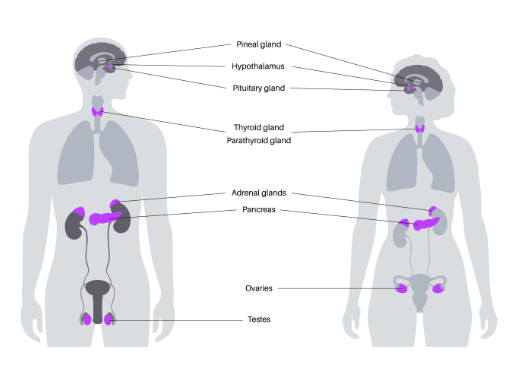 The endocrine system consists of glands without tubes, and these glands release substances called hormones. These hormones go straight into the blood from the glands. Hormones are like messengers in the blood and affect certain organs.
The endocrine system consists of glands without tubes, and these glands release substances called hormones. These hormones go straight into the blood from the glands. Hormones are like messengers in the blood and affect certain organs.
Adrenal Glands:
Adrenal glands are found above the kidneys. The adrenal cortex and adrenal medulla are two parts of the adrenal gland.
- The adrenal cortex releases cortisol, aldosterone, and androgens. Meanwhile, the adrenal medulla releases adrenaline and noradrenaline. Adrenaline is also called the "fight or flight" hormone or the "emergency hormone." It readies the body for handling physical stress during urgent moments, like danger, anger, or excitement.
Thyroid Gland:
- The thyroid gland is a big hormone-producing gland in the body, located in the neck, below the voice box. It makes two important hormones: triiodothyronine and thyroxine. Thyroxine manages how the body uses glucose, protein, and fat.
- Iodine is needed to create thyroxine. If there's not enough iodine in the diet, it can lead to a condition called goitre, which shows up as a swollen neck.
Pituitary Gland:
- The pituitary gland is like the boss gland that produces different hormones to control organs and other glands. It sits near the bottom of the brain. This gland releases hormones such as growth hormone, TSH, FSH, LH, ACTH, MSH, Vasopressin, and Oxytocin.
- The growth hormone manages the body's growth and development. If there's not enough of it during childhood, it can lead to dwarfism. On the other hand, too much of this hormone can cause gigantism.
Gonads:
Female gonads and male gonads are the two types of gonads found in humans.
Female Gonads:
- Oestrogen and progesterone are hormones made by the ovaries. Oestrogen controls changes linked to puberty, like a woman's voice, smooth skin, and the growth of mammary glands.
- Progesterone manages changes in the uterus during the menstrual cycle and helps sustain pregnancy.
Male Gonads:
- In males, a pair of testes constitutes the gonads.
- These testes are the male sex organs located outside the belly in the scrotum.
- The hormone testosterone is made by the testes.
- Testosterone controls the changes that happen during puberty, like a deeper voice, the growth of the penis, and the increase of facial and body hair.
The Pancreas:
- The pancreas is located below the stomach, in the curve of the duodenum. It has two jobs: one is to release substances outside the body (exocrine), and the other is to release substances inside the body (endocrine). The pancreas makes hormones like insulin, glucagon, somatostatin, and pancreatic polypeptide.
- Insulin is important because it manages the sugar levels in our blood. If there's not enough insulin, it can lead to high blood sugar and cause diabetes mell
The Pineal Gland:
- The pineal gland produces melatonin, a hormone found near the middle of the brain, above the diencephalon.
- Melatonin affects things like reproductive growth, sleep-wake cycles, and seasonal activities.
The Hypothalamus:
- The hypothalamus is a part of the brain that links the nervous and hormonal systems through the pituitary gland. This gland releases hormones such as Somatostatin and Dopamine.
Parathyroid Glands:
- There are two sets of tiny oval-shaped glands found on the back of the thyroid gland in the neck, and they are called parathyroid glands.
- These glands produce a hormone known as parathormone, which helps manage calcium and phosphate ions in both the bones and blood.
- When there is too little secretion, it can lead to tetany, and when there is too much secretion, it can result in osteoporosis.
The Thymus Gland:
- The thymus gland can be found in the upper part of the breastbone, in front of the heart. It makes a hormone called thymosin and helps T-lymphocytes grow up.
- The testes make the hormone testosterone.
- Systems for feedback manage how many hormones are released and when. For instance, if blood sugar levels go up, cells in the pancreas notice and make more insulin. When blood sugar levels drop, insulin release goes down.
The Nervous System
The nervous system collaborates with various organs to transmit electrical signals from the brain to different body parts. Neurons within the nervous system act as a working and structural component of the system.
Neuron
Neurons have three main parts: dendrites, Cyton, and Axon. Dendrites receive impulses from other neurons. Cyton processes the impulses received by dendrites. After Cyton processes the impulse, Axon transfers it to another neuron, muscle, or glands, depending on what is needed. Axon comes in two types: myelinated and unmyelinated. In myelinated neurons, the transfer of impulses is faster.
Different Parts of the Brain and their Importance
- Cerebrum: This part manages thinking, feelings, talking, reasoning, memory, and how we sense sounds and tastes. If it doesn't work right, a person might have trouble hearing or speaking.
- Cerebellum: Even though the names might seem alike, they're different brain parts. The cerebellum is in charge of how we move - walking, running, sitting, keeping our balance, and our posture.
- Pons: Think of the pons as the brain's messenger. It helps signals move from the back of the brain to the front part.
- Medulla Oblongata: This part controls things our body does automatically, like vomiting, sneezing, and yawning. It's also linked to the spinal cord, which runs down the back and oversees reflex actions.
Different Types of Nervous System
In Class 10 Chapter 7 science, we learn about three different types of nervous systems, and all of them are explained in detail in this section.
Central Nervous Systems (CNS)
The notes of Chapter 7 Science Class 10 from Vednatu adequately describe how the CNS, the part of our human body, is made from the spinal cord and brain. The CNS is protected by 3 main layers:
- The bony skull (cranium)
- The cerebrospinal fluid
- The meninges (Dura mater, Arachnoid and Pia mater)
Peripheral Nervous System
These are the nerves released by the brain and spinal cord for the human peripherals to function and communicate with the brain. This nervous system includes 12 cranial nerves and 31 spinal nerves.
Somatic Nervous System
The somatic nervous system is located in certain areas of the peripheral nervous system. It consists of nerves that manage all the actions we choose to do on our own.
Autonomic Nervous System
The final part in the notes about control and coordination in Class 10 is the ANS, or autonomic nervous system. This system brings together all the nerves in charge of actions the body does automatically. The ANS is split into two sections: the sympathetic and parasympathetic nervous systems. The sympathetic side readies the body for strenuous activity and is the one that decides whether to fight or flee.
Synapse
A synapse is a connection point for neurons, where they share information using electric signals. It acts like a link between a neuron and a gland or muscle in the human body. If synapses are not present in neurons and muscles, the transfer and receipt of electric signals won't happen. This leads to a lack of muscle movement, causing it to stay unchanged indefinitely.
Reflex Action
When a soccer ball is rushing toward you at high speed, you instinctively lower yourself and let the ball go over you. You do this without even thinking twice; that's what a reflex action is. It helps protect you from sudden accidents and injuries. As per the notes in Chapter 7 of Class 10 science, a reflex action is a sudden action the body does in response to stimuli. The pathway used for the electrical impulse to carry out the reflex action is called a reflex arc. On the flip side, the parasympathetic nervous system operates in the exact opposite manner. It makes your body feel calm and slows down many of its high-functioning parts.
CBSE Class 10 Science Notes Chapter 7 Important Topics
The CBSE Class 10 Science Notes for Chapter 7 on Control and Coordination include all the subjects discussed in the chapter. These notes aim to assist students in understanding different control and coordination methods without making it too complicated. Below, we have listed all the crucial topics that are important for exams. Topics Subtopics 7.1 - Animals - Nervous System
- What Happens in Reflex Actions?
- Human Brain
- How are these Tissues Protected?
- How Does the Nervous Tissue Cause Action?
7.2 - Coordination in Plants
- Immediate Response to Stimulus
- Movement Due to Growth
7.3 - Hormones in Animals
Benefits of CBSE Class 10 Science Notes Chapter 7
- From the notes for control and coordination students explore how our body functions and how it works together with the brain, receiving signals from it.
- By grasping the body's control and coordination, they can efficiently answer questions that may arise in the board exam related to this chapter.
- The human body is an intricate form of life. Understanding its operations in depth through these review notes makes learning about other life forms much simpler.
Control and Coordination Class 10 Notes PDF
Download notes for control and coordination to understand control and coordination Class 10 concepts in an easy way. These notes also explain coordination in plants, making the Control and Coordination PDF useful for exam preparation
CBSE Class 10 Science Notes Chapter 7 FAQs
How can one maintain a healthy nervous system?
Can stress affect control and coordination?
Are there real-world applications of studying control and coordination?
What is the significance of reflex actions in daily life?
How can students effectively study control and coordination in science?
Can I access free resources for control and coordination Class 10 notes?
Control and Coordination Class 10 Notes PDF
Study without using the internet
Key Features of Control and Coordination Class 10 Notes
- These notes assist students in understanding and reviewing all the subjects discussed in the chapter Control and Coordination.
- You can access these control and coordination class 10 notes free in PDF format, making it easy and convenient for students to study on any device they have. The Class 10 Science Chapter 7 Revision Notes include proper diagrams, examples, and definitions for all the important topics, serving as a comprehensive study resource for students.
- These notes are particularly useful for exam preparation, offering a quick review of important concepts. They are aligned with the most recent CBSE syllabus and exam format.

